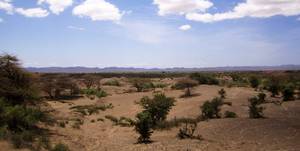News
27.03.2015
Humans have always come in different shapes and sizes
Tübingen researchers show that even our earliest ancestors varied in build
A joint study by researchers from the Universities of Tübingen and Cambridge demonstrates that the earliest members of our genus Homo varied widely in body size. Until now, we knew little about the height and weight of our ancestors who lived between 2.5 and 1.5 million years ago. Co-author of the study, Manuel Will, says even then, human populations varied in size. Will is a doctoral candidate at Tübingen’s institute of Early Prehistory and Quaternary Ecology. “These findings have important implications for the evolution of our genus,” he says. The study was published online yesterday in the Journal of Human Evolution.
Will worked with Cambridge anthropologist Jay Stock to compare the physiology of individuals from early human populations, using fossils from the famous Olduvai Gorge in Tanzania and from Koobi Fora in Kenya, as well as individuals from the “Cradle of Humankind” in South Africa. Their sample also included the oldest human fossils from outside Africa, from Dmanisi in Georgia. They found significant differences in body sizes which strongly indicate that there were at least two differently sized species of Homo living between 2.5 and 1.5 million years ago. Individuals from Koobi Fora (1.7-1.5 million years ago) stood up to around 165 cm and weighed 70kg on average, whereas their contemporaries from Olduvai appear to have been on average 20cm smaller and 20kg lighter.
The comparison between the African and Eurasian fossils showed that early humans grew bigger only after the first migrations out of Africa and more specifically around 1.7-1.5 million years ago within Africa in the Koobi Fora region. Furthermore, the Georgian fossils still possessed smaller bodies. Taken together, this belies the theory that bigger size was the necessary physical condition for the first humans to migrate to Eurasia according to study authors Will and Stock.
The researchers used mathematical formulas to determine the size of the bodies in life, extrapolat-ing from the fossil remains. Such fragments often reveal the genus but do not provide enough in-formation for researchers to determine the species with certainty.
For this reason, the Tübingen-Cambridge study did not classify the fossils according to species, instead using time and geography to determine the body-size difference in these early human populations. These two variables were easier to control, and at the same time, increased the sample size of early Homo individuals – because all the bone fragments from the right era and location could be included. “This innovative approach has allowed the researchers to shed new light on the evolution of body size within our genus,” says Professor Katerina Harvati-Papatheodorou, head of the Palaeoanthropology working group at Tübingen’s Institute of Prehistory and Medieval Archaeology.
The study is the most comprehensive of its kind to date and the first statistical investigation of body-size differences between early Homo species.
 |
|
Publication:
Will, M., Stock, J.T., Spatial and temporal variation of body size among early Homo, Journal of Human Evolution (2015), <link http: dx.doi.org j.jhevol.2015.02.009>
dx.doi.org/10.1016/j.jhevol.2015.02.009
<link http: www.sciencedirect.com science article pii s0047248415000287>
www.sciencedirect.com/science/article/pii/S0047248415000287
Contact:
Manuel Will, M.Phil.
University of Tübingen
Faculty of Science
Early Prehistory and Quaternary Ecology working group
Phone +49 7071 29-74993
<link mail ein fenster zum versenden der>manuel.will[at]uni-tuebingen.de
